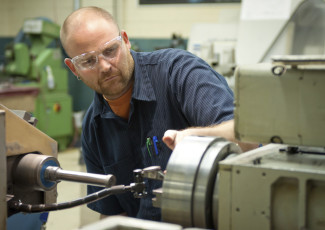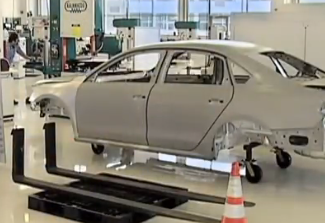Report Lauds Success of Advanced Manufacturing Program
By Heather Boerner
October 14, 2014
Center for Advanced Manufacturing forges a link between Kentucky community college and the workforce.
As pressure mounts to improve the link between a college education and a good-paying career, community colleges are increasingly investing in workforce partnerships to boost the quality of job training on campus.
At Kentucky’s Gateway Community and Technical College (GCTC) one such investment comes in the form of a $35 million Center for Advanced Manufacturing.
When the center, built with a combination of private donations and state and federal dollars, first opened its doors four years ago, administrators had a good feeling about the effort, which aimed to address a shortage of skilled manufacturing workers in the region. Now, as the college celebrates National Manufacturing Month, a new report proves that investment is paying off. Though educators say more must be done to close the skills gap.
Among the report’s findings:
- Northern Kentucky currently employs 10 percent of the state’s total manufacturing workforce.
- Boone County, where the college is located, is home to 48 percent of the manufacturing facilities in Northern Kentucky and 57 percent of total employment in the region.
- Since opening its doors in 2010, the GCTC Center for Advanced Manufacturing has served 1,100 students.
- The number of students earning apprenticeships, in which an employer pays for the student to attend GCTC while also linking them to hands-on training, has increased by 226 percent.
- Students earned a total 1,135 credentials through the GCTC manufacturing program since the GCTC Boone Campus first opened in 2005.
“Our report affirms the need to increase the pool of qualified talent for advanced manufacturing as the single most important challenge facing the industry and its training partners,” said GCTCS President and CEO Ed Hughes when the report was first released.
Commitment pays off
That affirmation has been a long time coming for Hughes who arrived in Northern Kentucky in 2001 with the goal of founding a comprehensive community and technical college with a focus on career and workforce training.
At the time, the local economy was struggling, having lost a quarter of its manufacturing base in little more than a year. Today, those jobs have started to come back. The report says the local economy projects to add 442 manufacturing jobs per year through 2020.
Through the center, the college has teamed up with employers to offer custom training in seven manufacturing disciplines. Many of these programs also provide access to internships and other on-the-job experiences.
The college offers training in specific manufacturing skills, such as welding and electrical work, as well as integrated skills programs intended to produce workers with a broad range of talents, from field electrical work to reading blueprints to operating complex pneumatic controls.
The college also prepares students to transfer to four-year engineering programs.
“Is it worth all this? It absolutely is,” says Hughes. “We know that the impact of one trained graduate in terms of the cost of training to a company is about $200,000. For our institutions, an average apprenticeship program will cost about $160,000 over four years. This is not an expense but an investment in the community of Northern Kentucky.”
Going forward
Hughes says the college is considering launching similar training centers for other job sectors, such as Internet technology and health care. GCTC is also in the process of creating an academy program for high school juniors and seniors to get students interested in technical careers in important science, technology, engineering and mathematics fields before they enroll in college.
As the center demonstrates, and Hughes is quick to point out, community colleges can’t do this work on their own. To reach people across the region who need new job training and retraining requires a collaborative effort between industry, local colleges and universities, K-12 schools and area community colleges.
“The skilled worker shortage is bigger than any one institution,” says Hughes. “We can tinker around the edges, but in order to move from 1,200 students to the number our companies are going to need, we will need to be bold.”
What bold steps has your college taken to close the skills gap? Tell us in the Comments.













